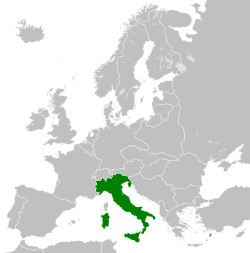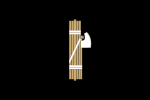Kingdom of Italy (1861–1946): Difference between revisions
More languages
More actions
mNo edit summary Tag: Visual edit |
No edit summary Tag: Visual edit |
||
| Line 1: | Line 1: | ||
{{Infobox country|name=Kingdom of Italiy|native_name=Regno d'Italia|image_flag=Kingdom of Italy flag.png|image_coat=Fascist Italy coast of arms.png|capital=[[Rome]]|mode_of_production=[[Capitalism]] (decaying)|government_type=(1922-1925) Unitary Bourgeois Democracy under Fascist influence<br>(1925-1943) Unitary Fascist State|leader_title1=Monarch|leader_name1=Victor Emmanuel III|leader_title2=Duce|leader_name2=[[Benito Mussolini]]|life_span=1922-1943|image_flag2=NFP flag.png|flag_caption=Flags of Italy and the [[National Fascist Party|Ruling Party]]|motto=Credere, obbedire, combattere<br>(Motto of the [[National Fascist Party]])|image_map=Kingdom of Italy map.png|religion=Roman Catholicism|legislature=Parliament|established_event1=[[March on Rome]]|established_date1=31 October 1922|established_event2=Second Italo-Abyssinian War|established_date2=1935-1936|established_event3=Conquest of Albania|established_date3=April 7–12, 1939|established_event4=Intervention into the [[Second World War]]|established_date4=10 June 1940|established_event5=Deposition of Mussolini|established_date5=25 July 1943|area_km2=3,798,000|population_estimate=42,993,602|population_estimate_year=1936|currency=Italian Lira}} | {{Infobox country|name=Kingdom of Italiy|native_name=Regno d'Italia|image_flag=Kingdom of Italy flag.png|image_coat=Fascist Italy coast of arms.png|capital=[[Rome]]|mode_of_production=[[Capitalism]] (decaying)|government_type=(1922-1925) Unitary Bourgeois Democracy under Fascist influence<br>(1925-1943) Unitary Fascist State|leader_title1=Monarch|leader_name1=Victor Emmanuel III|leader_title2=Duce|leader_name2=[[Benito Mussolini]]|life_span=1922-1943|image_flag2=NFP flag.png|flag_caption=Flags of Italy and the [[National Fascist Party|Ruling Party]]|motto=Credere, obbedire, combattere<br>(Motto of the [[National Fascist Party]])|image_map=Kingdom of Italy map.png|religion=Roman Catholicism|legislature=Parliament|established_event1=[[March on Rome]]|established_date1=31 October 1922|established_event2=Second Italo-Abyssinian War|established_date2=1935-1936|established_event3=Conquest of Albania|established_date3=April 7–12, 1939|established_event4=Intervention into the [[Second World War]]|established_date4=10 June 1940|established_event5=Deposition of Mussolini|established_date5=25 July 1943|area_km2=3,798,000|population_estimate=42,993,602|population_estimate_year=1936|currency=Italian Lira}} | ||
The '''Kingdom of Italy''', from the [[March on Rome]] in 1922 until 1943, was under the rule of the first [[Fascist]] state in history, in a historical period commonly known as '''Fascist Italy'''. | The '''Kingdom of Italy''', from the [[March on Rome]] in 1922 until 1943, was under the rule of the first [[Fascist]] state in history, in a historical period commonly known as '''Fascist Italy'''. While in the years from 1922-1925, the regime still maintained a Liberal façade, after 1925, it soon fully formed into a militantly [[Anti-communism|anti-communist]] dictatorship headed by [[Benito Mussonlini]].<ref>{{News citation|newspaper=Swansea University|title=What was the impact of Fascist rule upon Italy from 1922 to 1945?|url=https://www.swansea.ac.uk/history/history-study-guides/what-was-the-impact-of-fascist-rule-upon-italy-from-1922-to-1945/|retrieved=2022-7-19|quote=Mussolini’s appointment as prime minister in October 1922 did not see the immediate institution of dictatorial rule. Characteristic of the means the Fascists had employed to come to power, Blackshirt squad violence helped to reduce the influence of parliamentary opposition without outlawing it altogether. From the start of 1925, a fascist parliamentary majority (elected in April 1924 partly thanks to fascist intimidation) was able to pass a series of laws which dismantled the institutions of liberal democracy. Denoting a decline in squad power, the regular police forces together with the OVRA secret police (created in 1927) were now entrusted with the task of rooting out political opposition and controlling the population, with the assistance of Fascist Party organizations (including the Militia).}}</ref> | ||
Under the [[reactionary]] and despotic government, [[Communist party|socialist and communist organizations]], [[Trade union|trade unions]], and other organs of the [[working class]] saw massive repression and deprivation, with the economy being organized in accordance to the betterment of the [[Bourgeoisie|wealthy]], at the large expense of the workers. The fascist regime also impletmented the first modern privatization programs, as well as the mass cutting of social programs, in history.<ref>{{Citation|author=Germa Bel|year=2011|title=The first privatisation: selling SOEs and privatising public monopolies in Fascist Italy (1922–1925)|title-url=https://academic.oup.com/cje/article-abstract/35/5/937/1695860|quote=Italy's first Fascist government applied a large-scale privatisation policy between 1922 and 1925. The government privatised the State monopoly of match sale, eliminated the State monopoly on life insurances, sold most of the State-owned telephone networks and services to private firms, reprivatised the largest metal machinery producer, and awarded concessions to private firms to build and operate motorways. These interventions represent one of the earliest and most decisive privatisation episodes in the Western world. While ideological considerations may have had a certain influence, privatisation was used mainly as a political tool to build confidence among industrialists and to increase support for the government and the Partito Nazionale Fascista. Privatisation also contributed to balancing the budget, which was the core objective of Fascist economic policy in its first phase.|publisher=Cambridge Journal of Economics|doi=https://doi.org/10.1093/cje/beq051|volume=35|trans-lang=English}}</ref> | |||
[[Category:Fascist countries]] | [[Category:Fascist countries]] | ||
[[Category:Imperialist countries]] | [[Category:Imperialist countries]] | ||
Revision as of 07:54, 19 July 2022
| Kingdom of Italiy Regno d'Italia | |
|---|---|
| 1922-1943 | |
Motto: Credere, obbedire, combattere (Motto of the National Fascist Party) | |
 | |
| Capital | Rome |
| Religion | Roman Catholicism |
| Dominant mode of production | Capitalism (decaying) |
| Government | (1922-1925) Unitary Bourgeois Democracy under Fascist influence (1925-1943) Unitary Fascist State |
• Monarch | Victor Emmanuel III |
• Duce | Benito Mussolini |
| Legislature | Parliament |
| History | |
| 31 October 1922 | |
• Second Italo-Abyssinian War | 1935-1936 |
• Conquest of Albania | April 7–12, 1939 |
• Intervention into the Second World War | 10 June 1940 |
• Deposition of Mussolini | 25 July 1943 |
| Area | |
• Total | 3,798,000 km² |
| Population | |
• 1936 estimate | 42,993,602 |
| Currency | Italian Lira |
The Kingdom of Italy, from the March on Rome in 1922 until 1943, was under the rule of the first Fascist state in history, in a historical period commonly known as Fascist Italy. While in the years from 1922-1925, the regime still maintained a Liberal façade, after 1925, it soon fully formed into a militantly anti-communist dictatorship headed by Benito Mussonlini.[1]
Under the reactionary and despotic government, socialist and communist organizations, trade unions, and other organs of the working class saw massive repression and deprivation, with the economy being organized in accordance to the betterment of the wealthy, at the large expense of the workers. The fascist regime also impletmented the first modern privatization programs, as well as the mass cutting of social programs, in history.[2]
- ↑ “Mussolini’s appointment as prime minister in October 1922 did not see the immediate institution of dictatorial rule. Characteristic of the means the Fascists had employed to come to power, Blackshirt squad violence helped to reduce the influence of parliamentary opposition without outlawing it altogether. From the start of 1925, a fascist parliamentary majority (elected in April 1924 partly thanks to fascist intimidation) was able to pass a series of laws which dismantled the institutions of liberal democracy. Denoting a decline in squad power, the regular police forces together with the OVRA secret police (created in 1927) were now entrusted with the task of rooting out political opposition and controlling the population, with the assistance of Fascist Party organizations (including the Militia).”
"What was the impact of Fascist rule upon Italy from 1922 to 1945?". Swansea University. Retrieved 2022-7-19. - ↑ “Italy's first Fascist government applied a large-scale privatisation policy between 1922 and 1925. The government privatised the State monopoly of match sale, eliminated the State monopoly on life insurances, sold most of the State-owned telephone networks and services to private firms, reprivatised the largest metal machinery producer, and awarded concessions to private firms to build and operate motorways. These interventions represent one of the earliest and most decisive privatisation episodes in the Western world. While ideological considerations may have had a certain influence, privatisation was used mainly as a political tool to build confidence among industrialists and to increase support for the government and the Partito Nazionale Fascista. Privatisation also contributed to balancing the budget, which was the core objective of Fascist economic policy in its first phase.”
Germa Bel (2011). The first privatisation: selling SOEs and privatising public monopolies in Fascist Italy (1922–1925), vol. 35. Cambridge Journal of Economics. doi: https://doi.org/10.1093/cje/beq051 [HUB]



